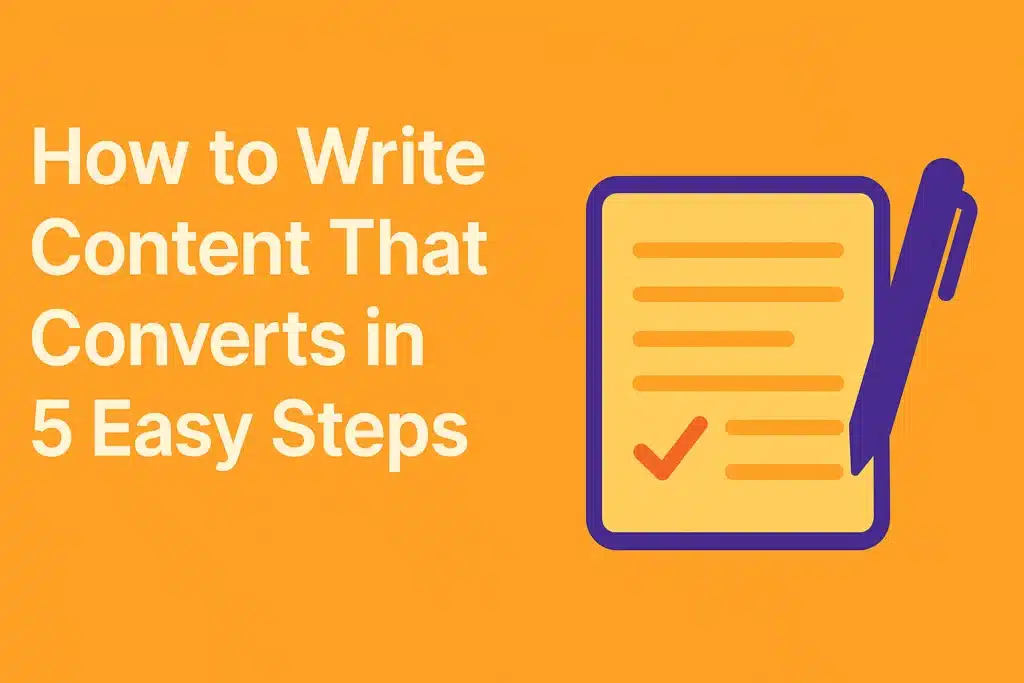Creating content that converts requires more than just good writing. It includes understanding your readers’ real needs and shaping every word to match their expectations. By focusing on customer-focused writing, you speak directly to their interests. When you include storytelling in marketing, you create emotional connections that lead to higher engagement. Then, by applying proven content marketing tactics, you guide them toward taking action. And when you finalize high converting landing pages, you remove barriers that prevent them from acting. Here is a simple approach to help you develop content that truly leads to results.
Step 1: Know Your Audience Deeply
Study your reader’s background, challenges, and everyday obstacles. Then build your message around those precise details. Clarify their goals, favored tone, and any barriers they confront. Address actual problems so your help feels genuine. This method ensures you create practical content that converts because it meets real and urgent needs.
Identify pain points and desires clearly
Review surveys, comments, and focus group feedback to show daily frustrations. Remove those barriers that block objectives so your readers feel understood. According to Bain & Company, raising retention by 5% can lift profits by up to 95% [M1 Project]. This finding proves urgency.
Segment audiences for tailored messaging
Organize readers by industry, interests, or present engagement to create messages more precise. Gartner discovered that six to 10 people typically join in B2B purchase decisions ([ZoomInfo](https://www.zoominfo.com)). That detail shows the importance of tailoring your approach for distinct segments in any ongoing marketing plan.
Study language that appeals emotionally
Use words that build trust, hope, or relief so readers connect with your message more. Identify triggers like fear or joy, then shape your copy so. This emotional insight helps you produce content that converts because it taps into real motivations and desires.
Step 2: Use Customer-Focused Writing
Highlight what matters to your reader instead of listing features they might not need. Address real personal pressures or doubts before they arise. Show how your solutions fit easily into their daily life. By focusing on them, you write content that converts because it speaks directly to each personal concern.
Write benefit-driven, not feature-heavy copy
Translate every product attribute into a relevant outcome for your audience. Instead of saying, “This tool has settings,” mention how it saves time or money. When you emphasize gains, you keep the focus on benefits that address genuine desires and prompt a faster decision.
Address reader objections upfront
List typical worries like price or reliability before the audience does. Address these concerns by providing reviews or FAQs. Reassure readers with clear value so they sense that your solution is safe and helpful. This approach removes doubt and supports a confident buying choice.
Use conversational tone to build trust
Write as if you are talking to a helpful friend. Neil Patel ran a test showing a 247% jump in full-article reads when using a casual voice ([Forge & Spark]. Simple words and short sentences keep readers interested and lower the risk of confusion.
Step 3: Add Storytelling in Marketing
Appeal to emotions by sharing real journeys that match your readers’ experiences. Place them at the center of your narrative so they see themselves moving from struggles to solutions. Emotional stories help build trust. This bond increases loyalty and revenue, often proving storytelling makes content that converts in many contexts.
Use narrative arcs to drive emotional buy-in
Start with a familiar problem your reader faces, introduce your product as the turning point, and end with a positive outcome. This structure creates emotional investment. Readers see how they can conquer issues using your solution, which encourages them to trust and act more.
Show transformations instead of listing facts
Paint a clear picture of before-and-after scenarios. Instead of itemizing details, show the journey your reader wants: a leap from today’s issue to a brighter place. This shift attracts attention and deepens engagement because people relate more to visible progress than to bare data.
Include customer stories for credibility
Show real wins from people who used your offer. Research indicates people recall stories 22 times more than data alone [NYT Licensing]. Share specific results, challenges, and improvements. These accounts inspire trust, reduce doubts, and position you as a reliable partner and boost conversions.
Step 4: Apply Strategic Content Marketing Tactics
Direct your readers with purposeful actions that support your core message. Map each piece of content to a goal like generating leads or boosting sales. Then publish in the channels your audience visits most. This organized approach improves exposure, increases engagement, and produces content that converts steadily and builds trust.
Intentionally place CTAs throughout content
Put calls to action at intervals so no one misses what to do next. Unbounce reports 90% of those who see headlines also read the CTA copy. Encourage signups, purchases, or shares, while guiding visitors to the right step at the moment.
Use strong visuals to support your message
Add images, infographics, or short videos that support your key points. The Content Marketing Institute highlights that visual storytelling can boost how people retain information ([Content Marketing Institute]. Present data or reviews well, and clearly let visuals break up text to hold attention longer.
Repurpose content across high-converting channels
Turn existing blogs into videos, podcasts, or emails. This increases your reach without constant new creation. According to LinkedIn, high-performing pieces guide repurposing choices. Adapt content for user habits on each platform to keep it engaging. This strategy extends brand awareness far.
Step 5: Design High Converting Landing Pages
Improve your landing pages so visitors move swiftly toward a conversion. Remove menu distractions, place strong headlines, and focus on a single goal. Combine every relevant element: clear copy with direct visuals and a bold call to action. When everything pushes one next step, you keep visitors on track and produce high converting landing pages.
Create effective and clear value propositions
Start with a headline that shows what you offer and why it matters. CXL notes visitors decide relevance within seconds ([CXL](https://cxl.com/blog/how-to-build-a-high-converting-landing-page/)). Use concise statements that highlight concrete benefits, and avoid confusion. A clear value promise guides them to act sooner and trust you more.
Use A/B testing to improve landing elements
Test different headlines, colors, or layouts to see what works. Ignite Visibility notes that many landing pages convert below 10%, often highlighting room for improvement [Ignite Visibility]. Tweak button text or images, measure results, and keep improving until you find the most successful approach.
Keep form fields and navigation minimal
Fewer boxes mean less resistance. CXL suggests minimizing form elements helps you capture more leads [CXL]. Remove unneeded links that pull visitors away. A clean layout keeps them focused on one outcome, increasing the chance they finish the action you want with fewer steps.
Conclusion
Creating content that converts includes clear steps, from understanding your target readers to tailoring each message around their specific needs. By crafting customer-focused paragraphs, using storytelling, and connecting every tactic with a definite goal, you build trust and prompt people to act. Adjust your landing pages with strong headlines, minimal distractions, and A/B testing to perfect each detail. Always remember that your final objective is to connect with real people seeking answers. When they sense genuine insight, they respond. Apply these strategies thoughtfully and review results often. This method paves the way toward growth and audience loyalty. Remember to keep your copy so you can adapt to new trends fast.
FAQ
Readers often want answers and information before using new strategies. Here are common questions about creating content that converts. Each response covers the essentials you need to refine your campaigns and produce measurable results. Apply them as you see fit.
What is content that converts and how does it drive sales?
Content that converts targets real reader needs and sparks direct action. It boosts sales by addressing pain points and guiding choices.
How does customer-focused writing improve engagement?
Customer-focused writing speaks straight to your audience’s challenges. It tailors benefits, resolves doubts, and keeps readers involved longer than feature-driven copy.
Why is storytelling in marketing effective for conversions?
Stories trigger emotion, which leads to deeper involvement. By spotlighting relatable transformations, marketing narratives make solutions memorable and easier to trust.
What content marketing tactics drive real ROI?
Customer grouping, consistent calls to action, and clever repurposing build targeted reach. Each tactic aligns with clear outcomes and boosts profits.
What makes high converting landing pages so effective?
They remove distractions, simplify copy, and focus on one purpose. Solid forms, strong offers, and streamlined design encourage decisive fast responses.
How often should I update content that converts best?
Regularly review performance data and metrics and user feedback. Refresh top-performing posts when customer needs shift or new information arise.

Ridam Khare is an SEO strategist with 7+ years of experience specializing in AI-driven content creation. He helps businesses scale high-quality blogs that rank, engage, and convert.



